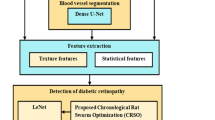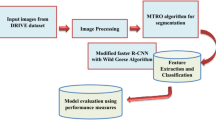Abstract
Diabetes mellitus frequently occurs with diabetic retinopathy (DR), which results in lesions mostly in the retinas that damages the vision. Earlier DR identification and treatment can deeply lower the threat of visual loss. Compared to computer-aided diagnosis methods, the manual diagnosing of DR by ophthalmologists using fundus images of the retina leads to high-cost consumption, time consuming, and more effort. This study employs an attention-based deep learning framework for classifying DR using fundus images, and the severity level is estimated to provide better treatment. The required fundus images are obtained through real-world benchmark datasets. Then, the attained images are pre-processed to remove unnecessary distortions in the images. Subsequently, the resultant pre-processed image is sent through the attention-based swin U-net for segmentation, where the affected diseased part is clearly visualized using the segmentation process. Here, the hybrid optimization algorithm named spiral bacterial colony optimization (SBCO) is utilized to optimize the features within the U-net. Furthermore, fundus images are classified using deep structures, where the segmented image is directly undergone to the 3-dimensional convolutional neural network (3D-CNN), and the optimally selected features from the segmentation stage are applied to the dual attention recurrent neural network (DA-RNN). For instance, the parameters inside the deep structures are optimized via the same developed SBCO. Finally, the severity level of the DR is calculated. Several experimental observations are done to evaluate the effectiveness of the developed deep structure-based DR detection approach, considering numerous performance metrics.


















Similar content being viewed by others
References
Qiao, L., Zhu, Y., & Zhou, H. (2020). Diabetic retinopathy detection using prognosis of microaneurysm and early diagnosis system for non-proliferative diabetic retinopathy based on deep learning algorithms. IEEE Access, 8, 104292–104302.
Agurto, C. (2010). Multiscale AM–FM methods for diabetic retinopathy lesion detection. IEEE Transactions on Medical Imaging, 29(2), 502–512.
Zhang, L., Li, Q., You, J., & Zhang, D. (2009). A modified matched filter with double-sided thresholding for screening proliferative diabetic retinopathy. IEEE Transactions on Information Technology in Biomedicine, 13(4), 528–534.
Narasimha-Iyer, H. (2006). Robust detection and classification of longitudinal changes in color retinal fundus images for monitoring diabetic retinopathy. IEEE Transactions on Biomedical Engineering, 53(6), 1084–1098.
Zeng, X., Chen, H., Luo, Y., & Ye, W. (2019). Automated diabetic retinopathy detection based on binocular siamese-like convolutional neural network. IEEE Access, 7, 30744–30753.
Momeni Pour, A., Seyedarabi, H., Abbasi Jahromi, S. H., & Javadzadeh, A. (2020). Automatic detection and monitoring of diabetic retinopathy using efficient convolutional neural networks and contrast limited adaptive histogram equalization. IEEE Access, 8, 136668–136673.
Majumder, S., & Kehtarnavaz, N. (2021). Multitasking deep learning model for detection of five stages of diabetic retinopathy. IEEE Access, 9, 123220–123230.
Zhao, Y., et al. (2017). Intensity and compactness enabled saliency estimation for leakage detection in diabetic and malarial retinopathy. IEEE Transactions on Medical Imaging, 36(1), 51–63.
Abdelsalam, M. M., & Zahran, M. A. (2021). A novel approach of diabetic retinopathy early detection based on multifractal geometry analysis for OCTA macular images using support vector machine. IEEE Access, 9, 22844–22858.
Mateen, M., Wen, J., Hassan, M., Nasrullah, N., Sun, S., & Hayat, S. (2020). Automatic detection of diabetic retinopathy: A review on datasets, methods, and evaluation metrics. IEEE Access, 8, 48784–48811.
Zhou, Y., Wang, B., Huang, L., Cui, S., & Shao, L. (2021). A benchmark for studying diabetic retinopathy: Segmentation, grading, and transferability. IEEE Transactions on Medical Imaging, 40(3), 818–828.
Pires, R., Avila, S., Jelinek, H. F., Wainer, J., Valle, E., & Rocha, A. (2017). Beyond lesion-based diabetic retinopathy: A direct approach for referral. IEEE Journal of Biomedical and Health Informatics, 21(1), 193–200.
Deperlioğlu, Ö., & Köse, U. (2018). Diagnosis of diabetic retinopathy using image processing and convolutional neural network. In 2018 Medical Technologies National Congress (TIPTEKNO) (pp. 1–4)
Hua, C.-H., et al. (2021). Convolutional network with twofold feature augmentation for diabetic retinopathy recognition from multi-modal images. IEEE Journal of Biomedical and Health Informatics, 25(7), 2686–2697.
Niu, Y., Gu, L., Zhao, Y., & Lu, F. (2022). Explainable diabetic retinopathy detection and retinal image generation. IEEE Journal of Biomedical and Health Informatics, 26(1), 44–55.
Aujih, A. B., Shapiai, M. I., Meriaudeau, F., & Tang, T. B. (2022). EDR-Net: Lightweight deep neural network architecture for detecting referable diabetic retinopathy. IEEE Transactions on Biomedical Circuits and Systems, 16(3), 467–478.
RobiulIslam, M., Abdulrazak, L. F., Nahiduzzaman, M., Goni, M. O. F., Anower, M. S., Ahsan, M., Haider, J., & Kowalski, M. (2022). Applying supervised contrastive learning for the detection of diabetic retinopathy and its severity levels from fundus images. Computers in Biology and Medicine, 146, 105602.
Sugeno, A., YasuyukiIshikawa, Ohshima, T., & Muramatsu, R. (2021). Simple methods for the lesion detection and severity grading of diabetic retinopathy by image processing and transfer learning. Computers in Biology and Medicine, 137, 104795.
Mary Dayana, A., & Sam Emmanuel, W. R. (2022). Deep learning enabled optimized feature selection and classification for grading diabetic retinopathy severity in the fundus image. Neural Computing and Applications, 34, 18663.
Vasireddi, H. K., Suganya Devi, K., & Raja Reddy, G. N. V. (2022). Deep feed-forward neural-network–based screening system for diabetic retinopathy severity classification using the lion optimization algorithm. Graefe’s Archive for Clinical and Experimental Ophthalmology, 260, 1245–1263.
Wang, J., Bai, Y., & Xia, B. (2020). Simultaneous diagnosis of severity and features of diabetic retinopathy in fundus photography using deep learning. IEEE Journal of Biomedical and Health Informatics, 24(12), 3397–3407.
Roslinemary, A., & Kavitha, P. (2021). Automated diabetic retinopathy detection and classification using stochastic coordinate descent deep learning architectures. Materialstoday: PROCEEDINGS, 80, 43.
Qureshi, I., Ma, J., & Abbas, Q. (2021). Diabetic retinopathy detection and stage classification in eye fundus images using active deep learning. Multimedia Tools and Applications, 80, 11691–11721.
Benasla, L., Belmadani, A., & Rahli, M. (2014). Spiral optimization algorithm for solving combined economic and emission dispatch. Electrical Power and Energy Systems, 62, 163–174.
Niu, B., & Wang, H. (2012). Bacterial colony optimization. Discrete Dynamics in Nature and Society. https://doi.org/10.1155/2012/698057
Cao, H., Wang, Y., Chen, J., Jiang, D., Zhang X., Tian, Q., & Wang, M. (2021) Swin-Unet: Unet-like pure transformer for medical image segmentation. Arxiv
Balaji, R., Gowtham Gowda, T., Aralere, H. K., & Priya, V. (2021). Spectral, spatial feature fusion using 3dcnn for hyperspectral image classification. International Research Journal of Modernization in Engineering Technology and Science, 3, 1.
Cecen, A., Dai, H., Yabansu, Y. C., Kalidindi, S. R., & Song, L. (2018). Material structure property linkages using three-dimensional convolutional neural networks. Acta Materialia, 146, 76–84. https://doi.org/10.1016/j.actamat.2017.11.053
Vaiyapuri, T., Jothi, A., Narayanasamy, K., Kamatchi, K., Kadry, S., & Kim, J. (2022). Design of a honey badger optimization algorithm with a deep transfer learning-based osteosarcoma classification model. Cancers, 14(24), 6066.
Vinoth Kumar, B., Zhang, S., Wu, T., Prakash, J., Zhou, L., & Li, K. (2022). A novel JAYA algorithm for optic disc localization in eye fundus images. International Journal of Computational Vision and Robotics, 12(3), 324–342.
Amalia, R., Bustamam, A., & Sarwinda, D. (2021). Detection and description generation of diabetic retinopathy using convolutional neural network and long short-term memory. Journal of Physics Conference Series, 1722(1), 012010.
Dua, M., Makhija, D., Manasa, P. Y. L., & Mishra, P. (2020). A CNN–RNN–LSTM based amalgamation for Alzheimer’s disease detection. Journal of Medical and Biological Engineering, 40, 688.
Jasper Gnana Chandran, J., Jabez, J., & Srinivasulu, S. (2023). Auto-metric graph neural network optimized with capuchin search optimization algorithm for coinciding diabetic retinopathy and diabetic macular edema grading. Biomedical Signal Processing and Control, 80, 104386.
Zulaikha Beevi, S. (2023). Multi-Level severity classification for diabetic retinopathy based on hybrid optimization enabled deep learning. Biomedical Signal Processing and Control, 84, 104736.
Uppamma, P., & Bhattacharya, S. (2023). Diabetic retinopathy detection: A blockchain and African vulture optimization algorithm-based deep learning framework. Electronics, 12(3), 742.
Zhang, C., Chen, P., & Lei, T. (2023). Multi-point attention-based semi-supervised learning for diabetic retinopathy classification. Biomedical Signal Processing and Control, 80, 104412.
Alwakid, G., Gouda, W., & Humayun, M. (2023). Deep learning-based prediction of diabetic retinopathy using CLAHE and ESRGAN for enhancement. Healthcare, 11, 863.
Balamurugan, N. M., Maithili, K., Rathish Babu, T. K. S., & Adimoolam, M. (2023). Stage-wise categorization and prediction of diabetic retinopathy using ensemble learning and 2D-CNN. Intelligent Automation and Soft Computing, 36(1), 499–514.
Mondal, S. S., Mandal, N., Singh, K. K., Singh, A., & Izonin, I. (2023). EDLDR: An ensemble deep learning technique for detection and classification of diabetic retinopathy. Diagnostics, 13(1), 124.
Jian, M., Chen, H., Tao, C., Li, X., & Wang, G. (2023). Triple-DRNet: A triple-cascade convolution neural network for diabetic retinopathy grading using fundus images. Computers in Biology and Medicine, 155, 106631.
Desika Vinayaki, V., & Kalaiselvi, R. (2023). ESLO: Enhanced sea lion optimization based bi-directional CNN–RNN for accurate detection of diabetic retinopathy. Concurrency and Computation Practice and Experience, 35(1), e7391.
Zhang, L., Liu, J., Ma, C., & Gui, H. (2023). Intelligent integrated framework towards high-accuracy machining. Engineering Science and Technology, an International Journal, 40, 101359.
Khodabandelou, G., Moon, H., Amirat, Y., & Mohammed, S. (2023). A fuzzy convolutional attention-based GRU network for human activity recognition. Engineering Applications of Artificial Intelligence, 118, 105702.
Rana, A., Reddy, A., Shrivastava, A., Verma, D., Ansari, M. S., & Singh D. (2022). Secure and smart healthcare system using IoT and deep learning models. In 2022 2nd international conference on technological advancements in computational sciences (ICTACS) (pp. 915–922).
Funding
This research did not receive any specific funding.
Author information
Authors and Affiliations
Contributions
All authors have made substantial contributions to conception and design, revising the manuscript, and the final approval of the version to be published. Also, all authors agreed to be accountable for all aspects of the work in ensuring that questions related to the accuracy or integrity of any part of the work are appropriately investigated and resolved.
Corresponding author
Ethics declarations
Conflict of interest
The authors declare no conflict of interest.
Additional information
Publisher's Note
Springer Nature remains neutral with regard to jurisdictional claims in published maps and institutional affiliations.
Rights and permissions
Springer Nature or its licensor (e.g. a society or other partner) holds exclusive rights to this article under a publishing agreement with the author(s) or other rightsholder(s); author self-archiving of the accepted manuscript version of this article is solely governed by the terms of such publishing agreement and applicable law.
About this article
Cite this article
Khaparde, A., Chapadgaonkar, S., Kowdiki, M. et al. An Attention-Based Swin U-Net-Based Segmentation and Hybrid Deep Learning Based Diabetic Retinopathy Classification Framework Using Fundus Images. Sens Imaging 24, 20 (2023). https://doi.org/10.1007/s11220-023-00426-5
Received:
Revised:
Accepted:
Published:
DOI: https://doi.org/10.1007/s11220-023-00426-5




